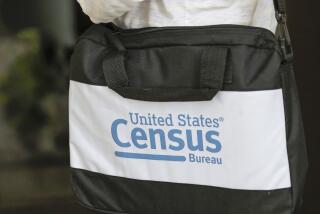Fooling With Census Again
- Share via
The 2000 census is little more than a year away. The nation’s decennial head count carries high stakes, determining each state’s clout in Congress and the federal dollars each receives. The census is always an awesome logistical endeavor, with questionnaires mailed to every resident and legions of “enumerators” sent out to find non-respondents. This time, however, the census is also the object of a nasty partisan battle.
In January, the U.S. Supreme Court blocked the use of modern statistical methods to apportion congressional seats. The Census Bureau has used statistical methods for decades to check the accuracy of its head count. This year the agency intended broader use of a method called sampling to prevent the undercounts that in 1990 cost Los Angeles and other big cities congressional seats and federal dollars. Republicans, in part prompted by the notion that the undercounted lean Democratic, argued that the Constitution and a 1976 law require an “actual enumeration,” and the court agreed. But the court allowed sampling for other purposes, including redistricting within states and the deciding of federal funding. That’s what the fight is over now.
A bill by Rep. Dan Miller (R-Fla.) would make it harder for the agency to produce that second, statistically sound count. His measure, now before the full House, would require the Census Bureau to conduct a duplicative, costly post-census check of addresses, ostensibly to make sure no one was missed. Miller’s bill also requires that this needless post-census review last nine weeks, even though in past years the bureau did it in two weeks.
Given that the Census Bureau must report its numbers to the president and Congress by specific deadlines, a nine-week delay raises the likelihood that the uncorrected, undercounted census will be used for redistricting and funding. This unfair, needless bill should be defeated.
More to Read
Get the L.A. Times Politics newsletter
Deeply reported insights into legislation, politics and policy from Sacramento, Washington and beyond. In your inbox twice per week.
You may occasionally receive promotional content from the Los Angeles Times.








